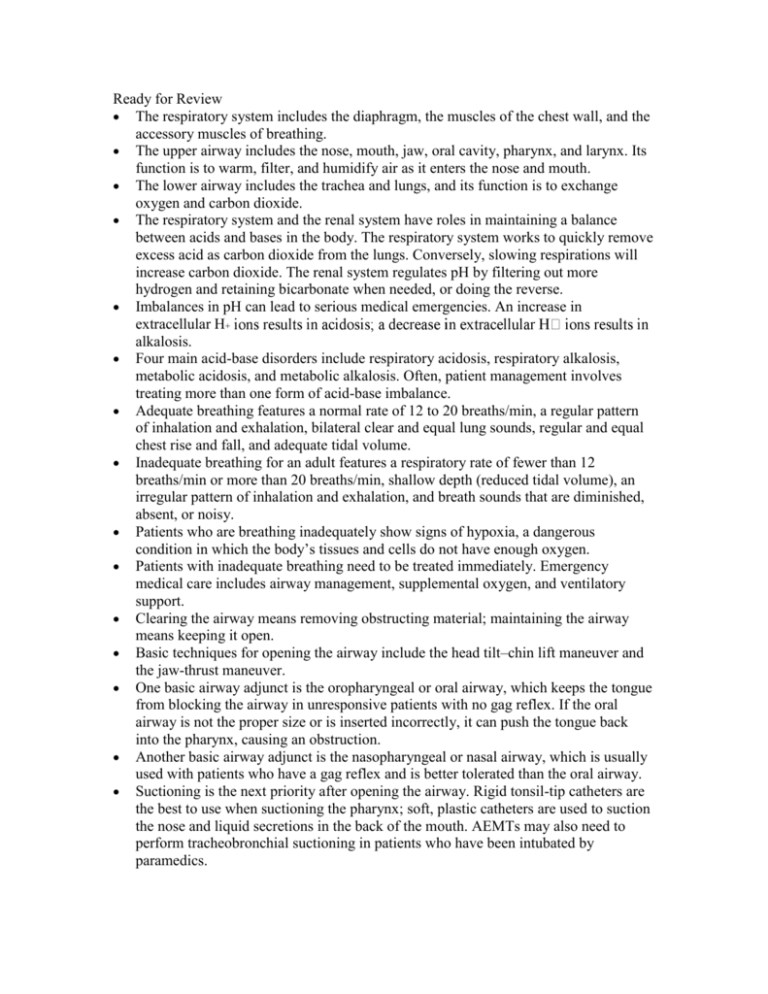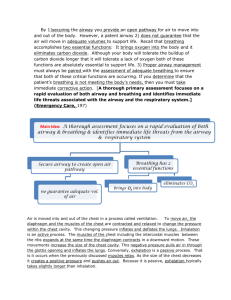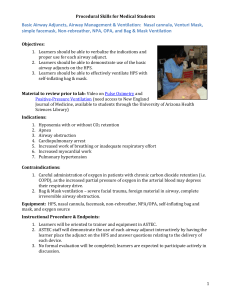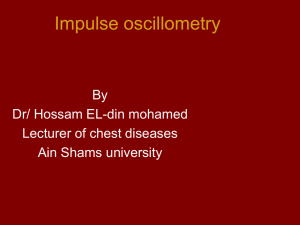Chapter 10
advertisement

Ready for Review The respiratory system includes the diaphragm, the muscles of the chest wall, and the accessory muscles of breathing. The upper airway includes the nose, mouth, jaw, oral cavity, pharynx, and larynx. Its function is to warm, filter, and humidify air as it enters the nose and mouth. The lower airway includes the trachea and lungs, and its function is to exchange oxygen and carbon dioxide. The respiratory system and the renal system have roles in maintaining a balance between acids and bases in the body. The respiratory system works to quickly remove excess acid as carbon dioxide from the lungs. Conversely, slowing respirations will increase carbon dioxide. The renal system regulates pH by filtering out more hydrogen and retaining bicarbonate when needed, or doing the reverse. Imbalances in pH can lead to serious medical emergencies. An increase in extracellular H alkalosis. Four main acid-base disorders include respiratory acidosis, respiratory alkalosis, metabolic acidosis, and metabolic alkalosis. Often, patient management involves treating more than one form of acid-base imbalance. Adequate breathing features a normal rate of 12 to 20 breaths/min, a regular pattern of inhalation and exhalation, bilateral clear and equal lung sounds, regular and equal chest rise and fall, and adequate tidal volume. Inadequate breathing for an adult features a respiratory rate of fewer than 12 breaths/min or more than 20 breaths/min, shallow depth (reduced tidal volume), an irregular pattern of inhalation and exhalation, and breath sounds that are diminished, absent, or noisy. Patients who are breathing inadequately show signs of hypoxia, a dangerous condition in which the body’s tissues and cells do not have enough oxygen. Patients with inadequate breathing need to be treated immediately. Emergency medical care includes airway management, supplemental oxygen, and ventilatory support. Clearing the airway means removing obstructing material; maintaining the airway means keeping it open. Basic techniques for opening the airway include the head tilt–chin lift maneuver and the jaw-thrust maneuver. One basic airway adjunct is the oropharyngeal or oral airway, which keeps the tongue from blocking the airway in unresponsive patients with no gag reflex. If the oral airway is not the proper size or is inserted incorrectly, it can push the tongue back into the pharynx, causing an obstruction. Another basic airway adjunct is the nasopharyngeal or nasal airway, which is usually used with patients who have a gag reflex and is better tolerated than the oral airway. Suctioning is the next priority after opening the airway. Rigid tonsil-tip catheters are the best to use when suctioning the pharynx; soft, plastic catheters are used to suction the nose and liquid secretions in the back of the mouth. AEMTs may also need to perform tracheobronchial suctioning in patients who have been intubated by paramedics. The recovery position is used to help maintain the airway in patients without traumatic injuries who are breathing adequately on their own. You must provide immediate artificial ventilations with supplemental oxygen to patients who are not breathing on their own. Patients with inadequate breathing may also require artificial ventilations to maintain effective tidal volume. Handle compressed gas cylinders very carefully; their contents are under pressure. Always make sure the correct pressure regulator is firmly attached before transporting a cylinder. The pin-indexing safety system features a series of pins on a yoke that must be matched with the holes on the valve stem of the gas cylinder. Pressure regulators reduce the pressure of gas in an oxygen cylinder to between 40 and 70 psi. Pressure-compensated flowmeters and Bourdon-gauge flowmeters permit the regulated release of gas measured in liters per minute. When oxygen therapy is complete, disconnect the tubing from the flowmeter nipple, and turn off the cylinder valve; then turn off the flowmeter. As long as there is a pressure reading on the regulator gauge, it is not safe to remove the regulator from the valve stem. Keep any possible source of fire away from the area while oxygen is in use. Nasal cannulas and nonrebreathing masks are used most often to deliver oxygen in the field. The nonrebreathing mask is the delivery device of choice for providing supplemental oxygen to patients who are breathing adequately but are suspected of having or are showing signs of hypoxia. With a flow rate set at 15 L/min and the reservoir bag preinflated, the nonrebreathing mask can provide more than 90% inspired oxygen. If the patient will not tolerate a nonrebreathing mask, apply a nasal cannula. Pulse oximetry, an assessment tool to evaluate the effectiveness of oxygenation, does not take the place of a good assessment. This measurement depends on adequate perfusion to the capillary beds and is inaccurate when the patient is cold or in shock or has been exposed to carbon monoxide. The methods of providing artificial ventilation include mouth-to-mask ventilation, one-person bag-mask device ventilation, two-person bag-mask ventilation, and the manually triggered ventilation device. The manually triggered ventilation device is not a recommended ventilation device by most standards. Your own exhaled breath combined with high-flow oxygen at 15 L/min through the oxygen inlet valve will give your patient up to 55% oxygen; a bag-mask device with an oxygen reservoir and supplemental oxygen can deliver nearly 100% oxygen. CPAP is a noninvasive method of providing ventilatory support for patients in respiratory distress or suffering from sleep apnea. It is imperative to be familiar with indications, contraindications, advantages, disadvantages, and special considerations when choosing the appropriate device. This is especially important when dealing with pediatric patients. Regardless of the method, aggressive airway management is essential to a positive patient outcome. When you are providing artificial ventilation, remember that ventilating too forcefully can cause gastric distention. Slow, gentle breaths during artificial ventilation can help to prevent gastric distention. Patients who have a tracheal stoma or a tracheostomy tube need to be ventilated through the tube or the stoma. Advanced devices that can be used by AEMTs to provide definitive airway management to patients unable to maintain their own airway include esophageal airways and multilumen airways. Multilumen airways have two tubes and can be inserted blindly. The Combitube is an example of such a device. A multilumen airway can be used to ventilate via the esophagus or the trachea based on placement. The King LT is a single lumen airway that is blindly inserted into the esophagus. When it is properly placed in the esophagus, the distal cuff seals the esophagus, while the proximal cuff seals the oropharynx. Openings located between these two cuffs provide ventilation of the lungs. The laryngeal mask airway (LMA) is designed to provide a conduit from the glottic opening to the ventilation device. When properly inserted, the opening of the LMA is positioned right at the glottic opening. The inflatable cuff conforms to the contours of the airway and makes a relatively airtight seal. The Cobra perilaryngeal airway is designed to slide easily along the hard palate and to hold the soft tissue away from the laryngeal inlet once in place. The distal tip is proximal to the esophagus and seals the hypopharnyx. When the cuff is inflated, it raises the tongue and creates an airway seal allowing for ventilation. Foreign body airway obstruction usually occurs during a meal in an adult or while a child is eating, playing with small objects, or crawling about the house. The earlier you recognize any airway obstruction, the better. You must learn to recognize the difference between airway obstruction caused by a foreign object and that caused by a medical condition. Foreign body airway obstructions are classified as being mild or severe. Patients with a mild airway obstruction are able to move adequate amounts of air and should be left alone. Patients with a severe airway obstruction cannot move any air at all and require immediate treatment. Perform abdominal thrusts on responsive adults and children with a severe airway obstruction. If the patient becomes unresponsive, begin CPR with compressions and then open the airway and look in the mouth (do not perform blind finger sweeps). Attempt to ventilate the patient, and if still obstructed, continue compressions and consider the use of a laryngoscope and Magill forceps to attempt to remove the obstruction if possible. Check for loose dental appliances in a patient before assisting ventilation. Loose appliances should be removed to prevent them from obstructing the airway. Tightfitting appliances should be left in place. Airway problems can be especially challenging in patients with serious facial injuries. Control bleeding with direct pressure and suction as necessary.






